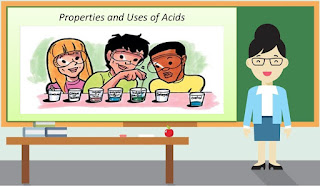Lesson Plan of Properties and Uses of Acids (Acids, Alkalies and Salts) General Science Grade VIII
Lesson Plan of Properties and Uses of Acids (Acids, Alkalies and Salts)
General Science Grade VIII
Students’ Learning Outcomes
·
Define acid in its own words.
·
Describe the properties of
acids.
·
Explain the uses of acids in
daily life.
Information for Teachers
·
Acids are the chemical
substances which give H’ ion in aqueous solution.
·
Acids have sour taste.
· Hydroelectric acid is found in our stomach.
·
Citric
acid in vitamin c.
·
They change blue litmus paper to red.
·
Acids react with bases to form salt and water (neutralization)
·
Acidic solutions are good electrical conductors.
Due to ionization in solution they form free mobile ions which conduct
electricity.
·
Acids are used in the production of metal,
paper, paint, detergent and fertilizers.
· Nitrite acid is used to make fertilizers like
ammonium nitrate. Sulfuric acid is used as home cleaner and also in car
batteries.
· Source of Acids:
Concept Map
·
Aqua Regina can dissolve
gold. It is made by adding one part concentrated nitrite acid to three parts of
concentrated hydroelectric acid.
·
Sulfuric acid is used in
almost all car batteries and also known as “Oil of Vitriol”.
·
The ‘fizz’ in soft drinks is
produced by adding carbolic acid (H2 CO3)
·
Acetic acid is extensively
used in food industry as a preservative.
·
Acid have a pH less than 7.
Material / Resources
For each group you require: blue litmus papers,
vinegar, beakers, lemon juice, water, stirrer, and pH
Worm up activity
·
Write the word, “Acidic
solution”, on the board and ask students to give their ideas about it.
·
Write all their ideas on the
board.
·
Development
Activity 1
·
Divide students in groups and
instruct them to:
o Dip blue litmus paper in vinegar.
o Observe what happens to the blue litmus paper.
·
Now ask these questions:
o What is the change in color of blue litmus
paper?
o Vinegar is an edible acid; can you predict its
taste? (Don’t allow children to taste anything in laboratory)
·
After getting students
response, conclude the activity by telling them that vinegar changes the blue
litmus paper into red because it is acidic in nature & it is sour in taste.
Activity 2
·
Divide students in pairs and
instruct them to :
o Take small amount of lemon juice in beaker A
and water in beaker B.
o Dip blue litmus paper in both the solutions.
o Observe what happens to the blue litmus on
dipping in the two solutions.
·
Now ask the following
questions:
o Did you see any change in the color of blue
litmus paper?
o What is the color difference of two litmus
papers dipped in different solutions in beaker A and B?
·
Conclude the activity by
telling that beaker ‘A’, turned blue litmus paper into red as lemon juice is
acidic in nature while beaker ‘B’, doesn’t affect the blue litmus paper because
contains water that is neutral.
Activity 3
·
Divide students in small
groups and instruct them to:
o
Take two beakers, label them A and B .
o
Half fill the two beakers with water.
o
Add one teaspoon of vinegar in beaker A.
o
Add 5 teaspoons of vinegar in beaker B.
o
Stir these mixtures.
o
Dip the strips of pH paper in the two solutions.
o
Note the pH values of both the solutions.
·
Now, ask the following questions:
o
What are the pH values of two solutions?
o
Which of the two solutions (A and B) has smaller
pH value and why?
·
Conclude the activity by telling the students
that the solution in beaker ‘A’, is dilute and solution in beaker ‘B’ is
concentrated. PH value of concentrated solution is less than pH value of dilute
solution.
·
Sum up / Conclusion
·
Teacher can conclude the
lesson by telling children that they leant about:
o
Acids give H’ ions in aqueous solutions and turn
blue litmus paper red.
o
Acids are of great use in fertilizers, car batteries
and industries etc.
o
Acidic solutions are good electrical conductors
in solutions.
Assessment
·
Why does acid rain destroy
buildings especially those made from limestone (a form of calcium carbonate)?
(Expected response: Acid rain
contains oxides of sulfur (SO2), which forms sulfuric acid on reacting with
water. Acids have a corrosive effect and can cause limestone building to
dissolve).
·
Name a fruit and a vegetable
that is acidic in nature. How did you guess it?
(Expected response: Fruit:
Oranges Vegetable: Lemon. They have sour taste.)
· Haynes has some transparent
liquid, which she claims to be an acid. How can you prove or disprove her
claim?
(Expected response: Dip a
blue litmus paper in transparent liquid. it becomes red which proves that it is
an acid)
Follow up
·
Ask the students to prepare a
booklet on acids. The booklet should contain colorful pictures related to the
sources, uses and properties of any two acids of your choice.












Comments
Post a Comment